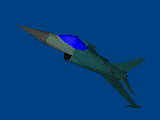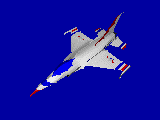


F-16 Fighting Falcon
Genesis of the successful F-16 fighter/attack aircraft lies in reaction to severe deficiencies in US fighter design revealed by the Vietnam War.
Following the success of the small, highly maneuverable F-86 day fighter in the Korean War, US fighter design changed to emphasize maximum speed, altitude, and radar capability at the expense of maneuverability, pilot vision, and other attributes needed for close combat. This trend reached its extremity in the McDonnell Douglas F-4 Phantom, which was the principal fighter for both the US Air Force and Navy during the latter part of the Vietnam War.
The F-4 was originally designed as an interceptor for defense of the fleet against air attack - a mission neither it nor any other jet has ever executed, because no US fleet has come under air attack since the beginning of the jet age. Be that as it may, the F-4 interceptor was designed to meet the fleet defense mission by using rapid climb to high altitude, high supersonic speed, and radar-guided missiles to shoot down threat aircraft at long distance.
Used as a fighter rather than as an interceptor in Vietnam, the F-4 was severely miscast. Against very inferior North Vietnamese pilots flying small, highly maneuverable MiG-21s, the air-to-air kill ratio sometimes dropped as low as 2 to 1, where it had been 13 to 1 in Korea. As the Vietnam War drew to a close, it was generally agreed that the F-4 had prohibitive deficiencies including:
- LARGENESS. F-4 pilots to frequently found themselves fighting at separation distances at which they could not see the smaller MiG-21s, but the MiG-21 pilots could see them.
- POOR PILOT VISION. In order to minimize high-speed drag, the F-4, and all combat aircraft before the F-14, does not have a bubble canopy. It is designed for a pilot to look straight ahead. Vision down and to the sides is poor; vision to the rear is nonexistent.
- MANEUVERABILITY. While the F-4 can pull 7G in turns, which was acceptable for that time, it can only do so by rapidly bleeding off energy (losing speed and/or altitude).
- TRANSIENT PERFORMANCE. Ability of the F-4 to change its maneuver (that is, to roll rapidly while pulling high Gs) was poor.
- COST. The large F-4 was an expensive aircraft to procure and maintain. This meant that, compared to the MiG-21, fewer aircraft could be bought with a given budget.
- NO GUN. The F-4 was designed without a gun, and was thus not capable of very close combat.
- COMBAT PERSISTENCE. While the ferry range of the F-4 was acceptable, its ability to engage in sustained hard maneuvering without running out of fuel was a significant problem.
These various sacrifices were rationalized by the belief that visual dogfighting was obsolete, and that in the supersonic age, air combat would be fought beyond visual range (BVR) using radar-guided missiles. This concept failed in Vietnam for two reasons: First, radar could detect and track aircraft but not identify them. Operating beyond visual range created an unacceptable risk of shooting down one's own aircraft. Pilots were therefore required to close to visually identify the target before shooting; this eliminated the theoretical range advantage of radar-guided missiles. Second, the performance of the Sparrow radar-guided missile in Vietnam was poor, generally yielding less than 10% kill per shot.
Dissatisfaction with these deficiencies led to the US Air Force F-15 and US Navy F-14 designs. On this page we discuss only the Air Force programs.
The original F-15 had excellent pilot vision, including being able to see 360 degrees in the horizontal plane. It had strong high-speed maneuverability and a 20mm cannon. In addition to rectifying some of the F-4's deficiencies, it could fly higher and faster than the F-4, and had dramatically better climb and acceleration.
It also had a powerful radar with advanced look-down shoot-down capability, and relied on the Sparrow missile as its principal weapon.
Nevertheless, an informal but influential group called the "Fighter Mafia" objected to the F-15 as moving in the wrong direction. (The most prominent Fighter Mafia spokesmen were systems analyst Pierre Sprey, test pilot Charles E. Meyers, and legendary fighter pilot John Boyd.)
The F-15, the Fighter Mafia objected, was even larger and more expensive than the F-4. Much of that money went into creating high maximum speed (Mach 2.5) and altitude (65,000 feet) and to serving as a launcher, under BVR conditions which couldn't be used in real combat,. for the Sparrow missile which didn't work While recognizing that the F-15 had phenomenal supersonic climb and maneuverability (it could sustain 6Gs at Mach 1.6), at such speeds it could not fight because its turn radius was so large that it could not keep the enemy in sight.
What the Air Force needed, the Mafia argued, was a successor to the WWII P-51 Mustang and the Korean War F-86 Saber: an all-new small fighter that would be cheap enough to buy in large numbers. (The F-104 was not considered a predecessor aircraft because, while it had excellent climb and acceleration, its wings were too small, leaving it deficient in range and maneuverability.) The new fighter would have revolutionary maneuverability, transient performance, acceleration, and climb at the subsonic and transonic speeds at which air combat is actually fought. It would have a gun and its primary armament would be the infra-red guided Sidewinder missile that had proven highly effective in Vietnam.
While Sidewinder's range was limited to about three miles, the Mafia argued that air combat beyond that range was fantasy in any case. Some members of the Mafia even suggested that the ideal small fighter would have no radar at all, although this was a minority view.
In any case, the Air Force establishment wanted no part of a new small fighter, with or without radar. It was regarded as a threat to the F-15, which was USAF's highest priority program. But the Fighter Mafia gained considerable resonance in Congress and within the Office of the Secretary of Defense. In 1971 Deputy Secretary of Defense David Packard began a Lightweight Fighter (LWF) program to explore the concept.
The LWF was to be about 20,000 pounds, or half the weight of the F-15, and was to stress low cost, small size, and very high performance at speed below Mach 1.6 and altitude below 40,000 feet. Two competing designs would be chosen for prototyping.
Industry recognized, correctly, that regardless of USAF hostility, LWF variants had great potential for profitable foreign military sales, including replacing the F-104. Single-engine designs were put forward by Boeing, General Dynamics, LTV, Northrop, and Rockwell. Northrop also proposed on a twin-engine design, in effect using Air Force money to develop a replacement for its F-5 export fighter.
The Boeing and General Dynamics designs were the clear leaders from the beginning, with the Northrop twin-engine design clearly the weakest of the six.
But midway through this stage of the competition, some potential foreign buyers expressed concern over buying a new single-engine fighter. The previous single-engine supersonic export fighter, the F-104, had a troublesome safety record that some buyers were disinclined to repeat.
USAF, therefore, decided that one of the two down-selectees had to have two engines. Since the last-place Northrop design was the only twin-engine contender, it became a down-selection winner by default.
When the General Dynamics design was chosen the other selectee on merit, Boeing was no doubt a bit miffed that its loss was caused by USAF changing the rules in mid-competition. But it did not protest the decision.
Of the two surviving designs, now designated the General Dynamics YF-16 and the Northrop YF-17., the YF-17 was a relatively conventional design, to some extent an outgrowth of the F-5, while the YF-16 was an all-new design incorporating highly innovative technologies that in many respects reached beyond those of the more expensive F-15. These included -
- FLY BY WIRE. From the outset, the YF-16 had no direct connection between the pilot's controls and the aircraft's control surfaces. Instead, the stick and rudder controls were connected to quadruple-redundant computers, which then told the elevators, ailerons, and rudder what to do. This had several large advantages over previous systems. It was quicker responding, automatically correcting for gusts and thermals with no effort from the pilot. It could be programmed to compensate for aerodynamic problems and fly like an ideal airplane. Most importantly, it enabled, with full safety, a highly efficient unstable design.
- NEGATIVE STABILITY. All previous aircraft designs had been aerodynamically stable. That is, the center of gravity was well in front of the center of lift and the center of pressure (drag).
- To illustrate the difference between stable and unstable designs, take a shirt cardboard and, holding it by the leading edge, pull it rapidly through the air. It will stretch out behind your hand in a stable manner. This is a stable design Now take it by the trailing edge push forward from there. It will immediately flip up or down uncontrollably. That is an unstable design.
- The downside of aerodynamic stability is that the aircraft is nose-heavy and always trying to nose down. The elevator must therefore push the tail down to level the airplane. But in addition to rotating the airplane from nose-down to level, the elevator is exerting negative lift; that is, it is pushing the airplane down. In order to counteract this negative lift, the wing needs to be made larger to create more positive lift. This increases both weight and drag, decreasing aircraft performance. In pitch-up situations including hard turns which are the bread and butter of aerial combat, this negative effect is greatly magnified.
- The YF-16 became the world's first aircraft to be aerodynamically unstable by design. With its rearward center of gravity, its natural tendency is to nose up rather than down. So level flight is created by the elevator pushing the tail up rather than down, and therefore pushing the entire aircraft up. With the elevator working with the wing rather than against it, wing area, weight, and drag are reduced. The airplane was constantly on the verge of flipping up or down totally out of control,. and this tendency was being constantly caught and corrected by the fly-by-wire control system so quickly that neither the pilot nor an outside observer could know anything was happening. If the control system were to fail, the aircraft would instantly disintegrate; however, this has never happened.
- HIGH G LOADS. Previous fighters were designed to take 7Gs, mainly because it was believed that the human pilot, even with a G-suit, could not handle more. The YF-16 seatback was reclined 30 degrees, rather than the usual 13 degrees. This was to increase the ability of the pilot to achieve 9Gs by reducing the vertical distance between head and heart. Additionally, the traditional center control stick was replaced by a stick on the right side, with an armrest to relieve the pilot of the need to support his arm when it weighed nine times normal.
- PILOT VISION. In addition to allowing full-circle horizontal vision and unprecedented vision over the sides, the YF-16 canopy was designed without bows in the forward hemisphere.
- GROWTH PREVENTION. Traditionally, room for growth has been considered an asset. Fighter aircraft have averaged weight gain of about one pound per day as new capabilities are added, cost increases, and performance declines. The F-15, for example, was designed with about 15 cubic feet of empty space to allow for future installation of additional equipment.. In a radical departure, the YF-16 was intentionally designed with very little empty space, (about two cubic feet)., with the explicit intention of preventing growth. One member of the House Armed Services Committee actually wrote to the Secretary of the Air Force asking that the F-16's empty space be filled with Styrofoam to insure that "gold-plated junk" was not added to the design.
- COMBAT RADIUS AND PERSISTENCE. General Dynamics chose a single turbofan engine, essentially the same engine as one of the two that powered the F-15. Use of a single engine helped minimize weight and drag; use of a turbofan rather than a pure jet engine gave high fuel efficiency. Additionally, the YF-16 designers used a "blended body" design in which the wing gradually thickened at the root and blended into the body contours without the usual visible joint. The space thus created was filled with fuel. With such a high fuel fraction and a fuel-efficient engine, the YF-16 was able to break the presumption that small aircraft were necessarily short-ranged.
- RADAR INTEGRATION. Because the YF-16 carried no radar-guided missiles, it could only fight within visual range. Moreover, the small weight and space available limited the range of its radar. Nevertheless, it was given a technologically advanced small radar, with excellent look-down capability. Most importantly, the radar was integrated with the visual combat mode. That is, the radar projected an image of the target aircraft onto the Head Up Display so that, by looking at that image, the pilot was looking exactly where the target would become visible as he approached it.
The competing Northrop YF-17 design was somewhat larger than the YF-16, and used two smaller pure jet engines. At the price of reduced range and persistence, the YF-17 avoided the main problem of the YF-16's turbofan: the inertia of the large fan required too long - in some cases six seconds - to spool up from idle to full power. In other respects, the YF-17 progressed better than expected, given its initial last place position.
Northrop argued that its twin-engine design added an essential safety factor, citing its experience with the small twin-engine F-5 fighter as an example. USAF did not find this persuasive, in part because a two engine plane with one engine out is useless in combat, and the probability of an engine failure was nominally twice as high with two engines as with one. The higher performance, better transient maneuverability, longer range, and lower cost of the YF-16 carried the day, and in 1976 the F-16 was chosen over the F-17.
USAF was then in the uncomfortable position of having a lightweight fighter design that could outmaneuver and outrange its pride and joy, the F-15 air superiority fighter. In real-world combat conditions, which meant Mach 1.2 or below, the F-16s held a significant edge over the F-15. To some extent this problem was solved by designating the F-16 as a "swing fighter" to do both air-to-air and air-to-ground, while the F-15 was to continue its aristocratic mission of pure air-to-air.
Probably the F-16's greatest asset during development was its unpopularity with the USAF establishment. Knowing that their airplane was in constant threat of cancellation, the General Dynamics designers were inspired to do everything possible and then some to maintain performance and prevent cost growth. For example, while the F-15 was about 25% titanium, titanium in the F-16 was limited to 2%. As another example, a fixed engine inlet was used to hold down cost, even though a variable inlet would have given better performance above Mach 1.5.
The F-16 has been, by any standard, a success. USAF has used it heavily and successfully for air-to-ground in the 1991 Gulf war and all subsequent conflicts. The Israeli Air Force has also had great success with it.
With the benefit of hindsight, it is worthwhile to look back from the current (2003) vantage point to see how the original concept has faired
- FLY BY WIRE has been a clear success. It is now used in essentially all military fixed wing aircraft and on many commercial aircraft.
- NEGATIVE STABILITY, or at least reduced positive stability, has worked without a failure - no F-16s have disintegrated in air from control system failure - and is coming into increasing use.
- HIGH G LOADS. The 9G standard pioneered by the F-16 is now universal for new fighter designs, although it is achieved more by pilot training than by hardware. Benefit of the 30-degree reclining seat back has not been clearly established, and many pilots find it increases the difficult of checking their six o'clock position while in hard maneuvers. So more recent designs have not copied the F-16 seat. Similarly, the side stick has worked well but has not proven as essential as its designers originally expected. One enduring controversy is whether control systems should, as is the case with the F-16 be programmed to unconditionally limit the aircraft to 9gs, or whether higher loads should be permitted in emergencies. One eminent General Dynamics test pilot, a "super pilot" who in his fifties was still able to sustain 9Gs for 45 seconds, published an article on the subject in "Code One", the General Dynamics house organ, arguing that there was not enough useful benefit in being able to exceed 9 Gs to justify the strain on the airframe, particularly since few pilots could retain functionality above 9Gs. Tragically and ironically, this pilot was killed when his plane, pulling 9Gs in a hard maneuver, was unable to pull up enough to avoid the impacting the ground. This outstanding pilot might have been able to function with a brief application of 10, 11, or even 12Gs. Could that have saved him and his aircraft? Could it save others in the future?
- PILOT VISION. Pilots like the F-16 canopy without front bows for its quietness as well as its vision. One drawback is that in order to avoid optical distortion in the bowless design, the conventional use of thick polycarbonate on the front to protect against birdstrike, and thinner polycarbonate for the rest of the canopy, cannot be used. Because the F-16 canopy uses thick polycarbonate throughout, it is not possible to eject by using the seat to puncture through the canopy. The canopy must first be blown off by small rockets, prolonging the ejection sequence slightly. On balance, the F-16 canopy concept is considered successful and it is continued in the F-22. On the other hand, neither Joint Strike Fighter candidate used full-circle vision, much less a bowless canopy.
- GROWTH PREVENTION. The original concept of a small day ait-to-air fighter was lost before the first production aircraft. The fuselage was extended so that the single-seat versions became as long as the two-seat version, and air-to-ground capability was added. As its life progressed, the F-16 became progressively larger and heavier as more capability, including the AMRAAM radar-guided missile, chaff and flare dispensers, and more hard points were added. Still, weight gain has been only about half the traditional pound per day, so the determination of the original designers has not been in vain.
- COMBAT RADIUS AND PERSISTENCE. The F-16 blended body has worked well, but has not been emulated in most newer designs.
- RADAR INTEGRATION. Integration of radar with visual systems has been fully successful and is now standard fighter design.
Variants
In January 1972, the Lightweight Fighter Program solicited design specifications from several American manufacturers. Participants were told to tailor their specifications toward the goal of developing a true air superiority lightweight fighter. General Dynamics and Northrop were asked to build prototypes, which could be evaluated with no promise of a follow-on production contract. These were to be strictly technology demonstrators. The two contractors were given creative freedom to build their own vision of a lightweight air superiority fighter, with only a limited number of specified performance goals. Northrop produced the twin-engine YF-17, using breakthrough aerodynamic technologies and two high-thrust engines. General Dynamics countered with the compact YF-16, built around a single F100 engine.
When the Lightweight Fighter competition was completed early in 1975, both the YF-16 and the YF-17 showed great promise. The two prototypes performed so well, in fact, that both were selected for military service.
On 13 January 1975 the Air Force announced that the YF-16's performance had made it the winner of its Air Combat Fighter (ACF) competition. This marked a shift from the original intention to use the two airplanes strictly as technology demonstrators. General Dynamics' YF-16 had generally shown superior performance over its rival from Northrop. At the same time, the shark-like fighter was judged to have production costs lower than expected, both for initial procurement and over the life cycle of the plane. At the same time, the YF-16 had proved the usefulness not only of fly-by-wire flight controls, but also such innovations as reclined seat backs and transparent head-up display (HUD) panels to facilitate high-G maneuvering, and the use of high profile, one-piece canopies to give pilots greater visibility. Thus, the Air Force had its lightweight fighter, the F-16.
The original F-16 was designed as a lightweight air-to-air day
fighter. Air-to-ground responsibilities transformed the first
production F-16s into multirole fighters. The empty weight of the
Block 10 F-16A is 15,600 pounds. The empty weight of the Block 50 is
19,200 pounds. The A in F-16A refers to a Block 1 through 20
single-seat aircraft. The B in F-16B refers to the two-seat
version. The letters C and D were substituted for A and B,
respectively, beginning with Block 25. Block is an important term
in tracing the F-16's evolution. Basically, a block is a numerical
milestone. The block number increases whenever a new production
configuration for the F-16 is established. Not all F-16s within a
given block are the same. They fall into a number of block subsets
called miniblocks. These sub-block sets are denoted by capital
letters following the block number (Block 15S, for example). From
Block 30/32 on, a major block designation ending in 0 signifies a
General Electric engine; one ending in 2 signifies a Pratt & Whitney
engine.
The F-16A, a single-seat model, first flew in December
1976. The first operational F-16A was delivered in January 1979 to the
388th Tactical Fighter Wing at Hill Air Force Base, Utah. The F-16B, a
two-seat model, has tandem cockpits that are about the same size as
the one in the A model. Its bubble canopy extends to cover the second
cockpit. To make room for the second cockpit, the forward fuselage
fuel tank and avionics growth space were reduced. During training, the
forward cockpit is used by a student pilot with an instructor pilot in
the rear cockpit.
- Block 1 and Block 5 F-16s
were manufactured through 1981 for USAF and for four European air
forces. Most Blocks 1 and 5 aircraft were upgraded to a Block 10
standard in a program called Pacer Loft in 1982.
- Block 10
aircraft (312 total) were built through 1980. The differences between
these early F-16 versions are relatively minor.
- Block 15 aircraft represent the most numerous version of
the more than 3,600 F-16s manufactured to date. The transition from
Block 10 to Block 15 resulted in two hardpoints added to the chin of
the inlet. The larger horizontal tails, which grew in area by about
thirty percent are the most noticeable difference between Block 15 and
previous F-16 versions.
The F-16C and F-16D aircraft, which are the single- and
two-place counterparts to the F-16A/B, incorporate the latest cockpit
control and display technology. All F-16s delivered since November
1981 have built-in structural and wiring provisions and systems
architecture that permit expansion of the multirole flexibility to
perform precision strike, night attack and beyond-visual-range
interception missions. All active units and many Air National Guard
and Air Force Reserve units have converted to the F-16C/D, which is
deployed in a number of Block variants.
- Block 25
added the ability to carry AMRAAM to the F-16 as well as
night/precision ground-attack capabilities, as well as an improved
radar, the Westinghouse (now Northrop-Grumman) AN/APG-68, with
increased range, better resolution, and more operating modes.
-
Block 30/32 added two new engines -- Block 30 designates a
General Electric F110-GE-100 engine, and Block 32 designates a Pratt &
Whitney F100-PW-220 engine. Block 30/32 can carry the AGM-45 Shrike
and the AGM-88A HARM, and like the Block 25, it can carry the AGM-65
Maverick.
- Block 40/42 - F-16CG/DG - gained capabilities for
navigation and precision attack in all weather conditions and at
night with the LANTIRN pods and more extensive air-to-ground loads,
including the GBU-10, GBU-12, GBU-24 Paveway laser-guided bombs and
the GBU-15. Block 40/42 production began in 1988 and ran through
1995. Currently, the Block 40s are being upgraded with several Block
50 systems: ALR-56M threat warning system, the ALE-47 advanced
chaff/flare dispenser, an improved performance battery, and Falcon
UP structural upgrade.
- Block 50/52 Equipped with a Northrop Grumman APG-68(V)7
radar and a General Electric F110-GE-129 Increased Performance Engine,
the aircraft are also capable of using the Lockheed Martin
low-altitude navigation and targeting for night (LANTIRN)
system. Technology enhancements include color multifunctional displays
and programmable display generator, a new Modular Mission Computer, a
Digital Terrain System, a new color video camera and color triple-deck
video recorder to record the pilot's head-up display view, and an
upgraded data transfer unit. In May 2000, the Air Force certitified
Block 50/52 [aka Block 50 Plus] F-16s to carry the CBU-103/104/105
Wind-Corrected Munitions Dispenser, the AGM-154 Joint Stand-Off
Weapon, the GBU-31/32 Joint Direct Attack Munition, and the Theater
Airborne Reconnaissance System. Beginning in mid-2000,
Lockheed-Martin began to deliver Block 50/52 variants equipped with an
on-board oxygen generation system (OBOGS) designed to replace the
obsolete, original LOX system.
- Block 50D/52D Wild Weasel F-16CJ (CJ means block
50) comes in C-Model (1 seat) and D-Model (2 seat) versions. It is
best recognized for its ability to carry the AGM-88 HARM and the
AN/ASQ-213 HARM Targeting System (HTS) in the suppression of enemy air
defenses [SEAD] mission. The HTS allows HARM to be employed in the
range-known mode providing longer range shots with greater target
specificity. This specialized version of the F-16, which can also
carry the ALQ-119 Electronic Jamming Pod for self protection, became
the sole provider for Air Force SEAD missions when the F-4G Wild
Weasel was retired from the Air Force inventory. The lethal SEAD
mission now rests solely on the shoulders of the F-16 Harm Targeting
System. Although F-18s and EA-6Bs are HARM capable, the F-16 provides
the ability to use the HARM in its most effective mode. The original
concept called for teaming the F-15 Precision Direction Finding (PDF)
and the F-16 HTS. Because this teaming concept is no longer feasible,
the current approach calls for the improvement of the HTS
capability. The improvement will come from the Joint Emitter Targeting
System (JETS), which facilitates the use of HARM's most effective mode
when launched from any JETS capable aircraft.
- Block 60 - In May 1998 the UAE announced selection of the
Block 60 F-16 to be delivered between 2002-2004. The upgrade
package consists of a range of modern systems including conformal
fuel tanks for greater range, new cockpit displays, an internal
sensor suite, a new mission computer and other advanced features
including a new agile beam radar.
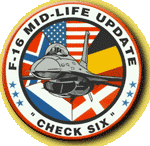 The Common Configuration Implementation Program (CCIP) for the USAF's F-16C/D fleet provides significant avionics upgrades to Block 40 and 50 F-16s,
ensuring their state-of-the-art capability well into the 21st century. A key
element of the upgrade is a common hardware and software avionics configuration for these two blocks that will bring together the Block 40/42 and 50/52 versions into a common configuration of core avionics and software. The avionics changes consist of the following systems: Link 16 Multifunctional Information Distribution System (MIDS), Joint Helmet-Mounted Cueing System (JHMCS), commercial expanded programmable display generator, color multifunction display set, modular mission computer, mux loadable data entry display set and an electronic horizontal situation display. This package contains a number of systems being incorporated into European F-16s in the F-16A/B Mid-Life Update program. The first aircraft upgraded under CCIP were delivered to combat units in December 2001 (1).
The Air Force will soon be flying only Block 40/42 and Block 50/52 F-16s in its active-duty units. Block 25 and Block 30/32 will be concentrated in Air National Guard and Air Force Reserve units.
The Common Configuration Implementation Program (CCIP) for the USAF's F-16C/D fleet provides significant avionics upgrades to Block 40 and 50 F-16s,
ensuring their state-of-the-art capability well into the 21st century. A key
element of the upgrade is a common hardware and software avionics configuration for these two blocks that will bring together the Block 40/42 and 50/52 versions into a common configuration of core avionics and software. The avionics changes consist of the following systems: Link 16 Multifunctional Information Distribution System (MIDS), Joint Helmet-Mounted Cueing System (JHMCS), commercial expanded programmable display generator, color multifunction display set, modular mission computer, mux loadable data entry display set and an electronic horizontal situation display. This package contains a number of systems being incorporated into European F-16s in the F-16A/B Mid-Life Update program. The first aircraft upgraded under CCIP were delivered to combat units in December 2001 (1).
The Air Force will soon be flying only Block 40/42 and Block 50/52 F-16s in its active-duty units. Block 25 and Block 30/32 will be concentrated in Air National Guard and Air Force Reserve units.
Service Life
The Falcon Up Structural Improvement Program program incorporates several major structural modifications into one overall program, affecting all USAF F-16s. Falcon Up will allow Block 25/30/32 aircraft to meet a 6000 hour service life, and allow Block 40/42 aircraft to meet an 8000 hour service life.
In view of the challenges inherent in operating F-16s to 8,000 flight hours, together with the moderate risk involved in JSF integration, the Department has established a program to earmark by FY 2000 some 200 older, Block 15 F-16 fighter aircraft in inactive storage for potential reactivation. The purpose of this program is to provide a basis for constituting two combat wings more quickly than would be possible through new production. This force could offset aircraft withdrawn for unanticipated structural repairs or compensate for delays in the JSF program. Reactivating older F-16s is not a preferred course of action, but represents a relatively low-cost hedge against such occurrences.
Specifications
|
| Primary Function | Multirole fighter
|
| Builder | Lockheed Martin Corp.
|
| Power Plant | F-16C/D:
one Pratt and Whitney F100-PW-200/220/229 or
one General Electric F110-GE-100/129
|
| Thrust | F-16C/D, 27,000 pounds(12,150 kilograms)
|
| Length | 49 feet, 5 inches (14.8 meters)
|
| Height | 16 feet (4.8 meters)
|
| Wingspan | 32 feet, 8 inches (9.8 meters)
|
| Speed | 1,500 mph (Mach 2 at altitude)
|
| Ceiling | Above 50,000 feet (15 kilometers)
|
| Maximum Takeoff Weight | 37,500 pounds (16,875 kilograms)
|
| Combat Radius [F-16C] |
740 nm (1,370 km) w/
2 2,000-lb bombs + 2 AIM-9 + 1,040 US gal external tanks
340 nm (630 km) w/
4 2,000-lb bombs + 2 AIM-9 + 340 US gal external tanks
200 nm (370 km) + 2 hr 10 min patrol
w/ 2 AIM-7 + 2 AIM-9 + 1,040 US gal external tanks
|
| Range |
Over 2,100 nm (2,425 mi; 3,900 km)
|
| Armament | One M-61A1 20mm multibarrel cannon with 500 rounds; external stations can carry up to six air-to-air missiles, conventional air-to-air and air-to-surface munitions and electronic countermeasure pods.
|
| Systems |
AN/APG-66 pulsed-Doppler radar
AN/AAQ-13 LANTIRN NAVIGATION POD
AN/AAQ-14 LANTIRN/SHARPSHOOTER
AN/AAQ-20 PATHFINDER NAVIGATION POD
AN/AAS-35 PAVE PENNY LASER SPOT TRACKER POD
AN/ASQ-213 HARM TARGETING SYSTEM POD
AN/ALQ-119 ECM POD
AN/ALQ-131 ECM POD
AN/ALQ-178 internal ECM
AN/ALQ-184 ECM POD
AN/ALR-56M threat warning receiver [F-16C/D Block 50/52]
AN/ALR-69 radar warning system (RWR)
AN/ALR-74 radar warning system (RWR) [replaces AN/ALR-69]
AN/ALE-40 chaff/flare dispenser
AN/ALE-47 chaff/flare dispenser
|
Unit cost $FY98
[Total Program] | F-16C/D, $26.9 million [final order]
|
| Crew | F-16C: one; F-16D: one or two
|
| Date Deployed | January 1979
|
Total Production
[for USAF] |
| 1-seat
F-16 A&C | 2-seat
F-16 B&D | TOTAL |
| Block 1 | 21 | 22 | 43 |
| Block 5 | 89 | 27 | 116 |
| Block 10 | 145 | 25 | 170 |
| Block 15 | 409 | 46 | 455 |
| Block 25 | 209 | 35 | 244 |
| Block 30 | 360 | 48 | 408 |
| Block 32 | 56 | 5 | 61 |
| Block 40 | 234 | 31 | 265 |
| Block 42 | 150 | 47 | 197 |
| Block 50 | 175 | 28 | 203 |
| Block 52 | 42 | 12 | 54 |
|
| F-16A/B | 674 | 121 | 795 |
| F-16C/D | 1,216 | 205 | 1,421 |
| TOTAL | 1,890 | 326 | 2,216 |
F-16C Block 50 currently in production
Final 3 aircraft ordered in FY1998
15 aircraft to be delivered after 01 Jan 99
Final aircraft of 2216 delivered March 2001
|
Inventory
As of Sept. 30, 2001
|
|
PAI |
TAI |
| Active Duty |
638 |
735 |
| Air National Guard |
462 |
576 |
| Air Force Reserve |
59 |
70 |
| Totals |
1159 |
1381 |
|
PMAI
Primary Mission Aircraft Inventory |
246 Air Combat Command
126 Pacific Air Forces
72 US Air Forces Europe
60 Air Force Reserve
315 Air National Guard
105 Air National Guard Air Defense Force
924 TOTAL
Only combat-coded aircraft
Excludes development/ test, attrition reserve, depot maintenance, and training aircraft.
|
F-16 Mission Missile Configurations
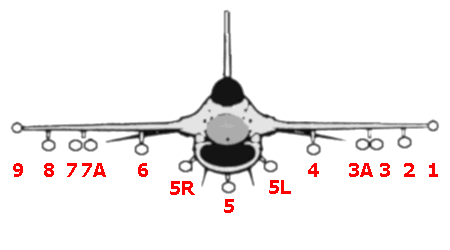
|
F-16 Rail Stores Loadings |
|
Right Wing |
|
|
|
|
|
Center |
|
|
|
|
|
Left Wing |
|
Rail ID |
|
9 |
8 |
7 |
7a |
6 |
5R |
5 |
5L |
4 |
3a |
3 |
2 |
1 |
|
Defensive Counterair |
|
AMRAAM |
AMRAAM |
Sidewinder |
|
370g Tank |
|
|
|
370g Tank |
|
Sidewinder |
AMRAAM |
AMRAAM |
|
Interdiction 1 |
|
AMRAAM |
|
GBU24 |
|
370g Tank |
|
LANTIRN |
|
370g Tank |
|
GBU24 |
|
AMRAAM |
|
Interdiction 2 |
|
Sidewinder |
|
AGM65 |
|
370g Tank |
|
ECM Pod |
|
370g Tank |
|
AGM65 |
|
Sidewinder |
|
Suppress Enemy Air Defense |
|
Sidewinder |
|
Harm |
|
370g Tank |
|
LANTIRN |
|
370g Tank |
|
Harm |
|
Sidewinder |
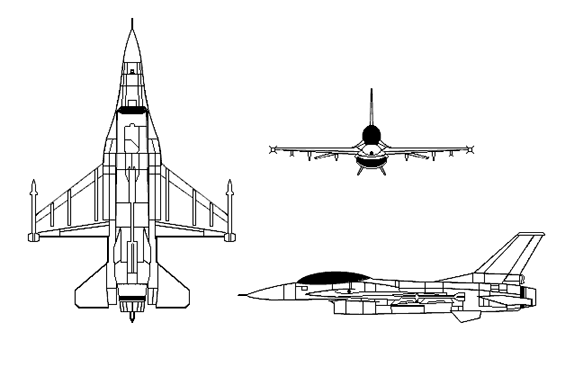
F-16
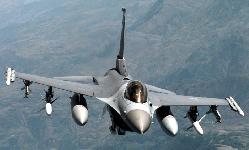
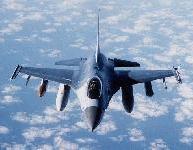
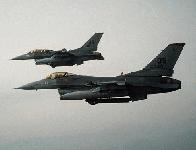
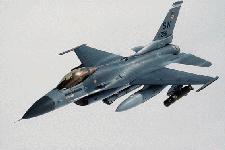
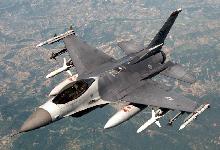
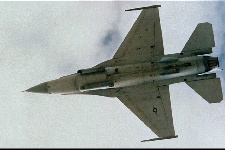
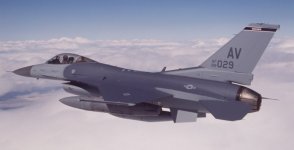
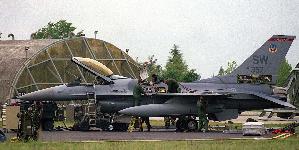
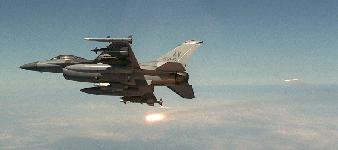
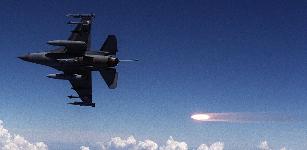
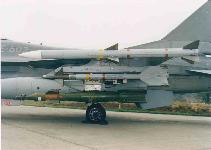
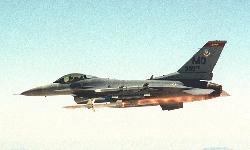


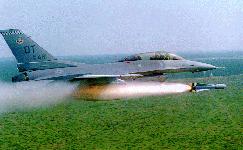
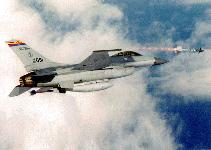


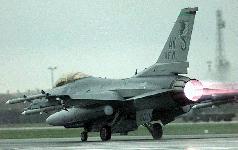
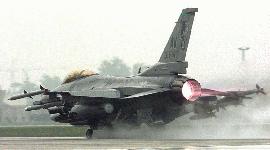
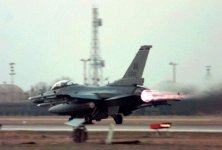
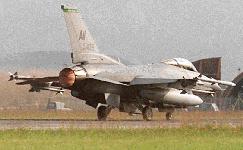

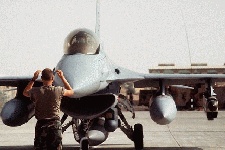

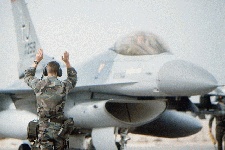
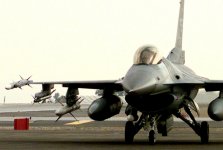
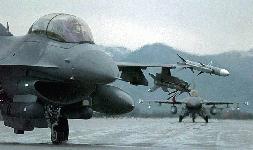



Block 50D/52D F-16CJ Wild Weasel
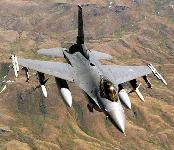
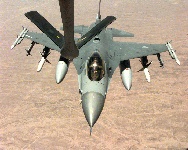
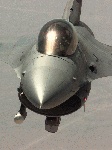
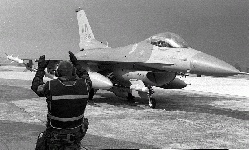
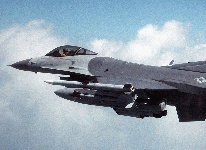


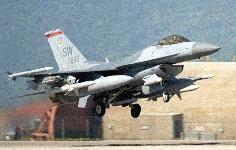
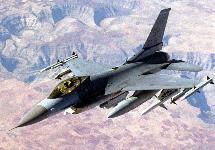
Sources and Resources
- F-16 COMBAT AIRCRAFT FUNDAMENTALS MULTI-COMMAND HANDBOOK 11-F16 VOLUME 5 : 10 MAY 1996 [4478kb PDF, and well worth the wait for the serious trivia buff] This handbook provides F-16 pilots a single-source, comprehensive document containing fundamental employment procedures and techniques that may be used to accomplish the various missions of the F-16. This handbook is the primary F-16 fighter fundamentals reference document for Air Combat Command (ACC), Pacific Air Forces (PACAF), United States Air Forces in Europe (USAFE), Air Force Reserve (USAFR), Air National Guard (ANG), and Air Education and Training Command (AETC). Designed to be used in conjunction with MCM 3–1 (S) and AFI/MCI 11-series directives, this handbook
addresses basic flying tasks and planning considerations for both the air-to-air and air-to-surface arenas. It presents a solid foundation on which effective tactics can be developed. This handbook is not designed to be used as a step-by-step checklist of how to successfully employ fighters, but rather provides information and guidelines on basic procedures and techniques.
- PILOT OPERATIONAL PROCEDURES--F-16 MULTI-COMMAND INSTRUCTION 11-F16 VOLUME 3 21 APRIL 1995 -- [185kb PDF] This instruction prescribes standard operational and weapons employment procedures to be used by all tactical pilots operating USAF F-16 aircraft.
- General Dynamics F-16 by Joe Baugher
- General Dynamics F-16 "Fighting Falcon" @ USAF Museum Fighter Gallery
- STP - F-16 MLU Most extensive article on the F-16 Mid-Life Update available anywhere
- F-16 Evolution (article from July 1997 Code One Magazine)
- F-16 Fighting Falcon - Lockheed Martin Corp.
- ANNEX F Common Solution/Concept List (U) Air Force Mission Area Plan (MAP) [as of 11 July 1997 - Rev 10] - Detailed and comprehensive Air Combat Command descriptions of weapon system modernization efforts required to satisfy known needs.
- 1Lockheed Martin – USAF Teamwork Moves F-16 CCIP Modification Ahead of Schedule
Foreign Military Sales
United Arab Emirates
Text: Vice President Gore Lauds Sale of F-16 Jets to the UAE 05 March 2000 -- Vice President Al Gore congratulated Lockheed Martin and the United Arab Emirates on the announcement from Abu Dhabi that they have completed terms on the sale of 80 F-16 fighter jets to the UAE.
https://www.fas.org/man/dod-101/sys/ac/f-16.htm
Maintained by Steven Aftergood




 The Common Configuration Implementation Program (CCIP) for the USAF's F-16C/D fleet provides significant avionics upgrades to Block 40 and 50 F-16s,
ensuring their state-of-the-art capability well into the 21st century. A key
element of the upgrade is a common hardware and software avionics configuration for these two blocks that will bring together the Block 40/42 and 50/52 versions into a common configuration of core avionics and software. The avionics changes consist of the following systems: Link 16 Multifunctional Information Distribution System (MIDS), Joint Helmet-Mounted Cueing System (JHMCS), commercial expanded programmable display generator, color multifunction display set, modular mission computer, mux loadable data entry display set and an electronic horizontal situation display. This package contains a number of systems being incorporated into European F-16s in the F-16A/B Mid-Life Update program. The first aircraft upgraded under CCIP were delivered to combat units in December 2001 (1).
The Air Force will soon be flying only Block 40/42 and Block 50/52 F-16s in its active-duty units. Block 25 and Block 30/32 will be concentrated in Air National Guard and Air Force Reserve units.
The Common Configuration Implementation Program (CCIP) for the USAF's F-16C/D fleet provides significant avionics upgrades to Block 40 and 50 F-16s,
ensuring their state-of-the-art capability well into the 21st century. A key
element of the upgrade is a common hardware and software avionics configuration for these two blocks that will bring together the Block 40/42 and 50/52 versions into a common configuration of core avionics and software. The avionics changes consist of the following systems: Link 16 Multifunctional Information Distribution System (MIDS), Joint Helmet-Mounted Cueing System (JHMCS), commercial expanded programmable display generator, color multifunction display set, modular mission computer, mux loadable data entry display set and an electronic horizontal situation display. This package contains a number of systems being incorporated into European F-16s in the F-16A/B Mid-Life Update program. The first aircraft upgraded under CCIP were delivered to combat units in December 2001 (1).
The Air Force will soon be flying only Block 40/42 and Block 50/52 F-16s in its active-duty units. Block 25 and Block 30/32 will be concentrated in Air National Guard and Air Force Reserve units.

